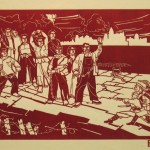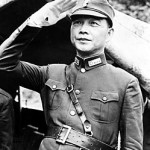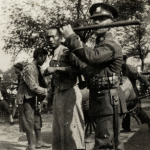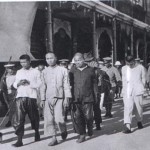
In April 1927 Guomindang forces, aided by urban gangsters and warlord militia, attacked members of the Chinese Communist Party (CCP) in Shanghai. Hundreds of communists were rounded up, arrested and tortured; most were executed or assassinated. The Shanghai Massacre, or ‘April 12th Incident’ as it is sometimes called, was a pivotal moment in the Chinese Revolution. It triggered a nationwide purge of communists from the Guomindang and several years of anti-communist violence, dubbed the ‘White Terror’. Surviving communists were either forced underground or into rural and provincial areas outside Guomindang control. The events of April 1927 marked the end of the First United Front between the CCP and Guomindang and the end of Soviet Russian support for the Nationalists. The CCP leadership was forced to reassess its revolutionary strategy in the wake of the events in Shanghai. Many historians consider this the starting point of the Chinese Civil War.
When Sun Yixian (Sun Yat-sen) died in March 1925, the nominal leadership of the Guomindang passed to Sun’s ideological protege Wang Jingwei, a member of the party’s left wing. Though not a significant political leader, Jiang Jieshi (Chiang Kai-shek) exerted considerable influence because of his military leadership. In June 1926, right-wing power brokers in the Guomindang organised Jiang’s elevation to commander-in-chief of the National Revolutionary Army (NRA). The following month the NRA embarked on the Northern Expedition, an ambitious campaign to suppress warlords in northern China to achieve Sun Yixian’s dream of reunification. The first phase of the Northern Expedition (1926-27) was generally successful. The NRA was well trained and organised, competently led by Huangpu graduates and equipped with Russian and German weapons. It also enjoyed the support of Chinese civilians who were fed up with warlord rule. Outnumbered and outgunned, many warlords capitulated and agreed to align with the Guomindang. Their private armies were dissolved or absorbed into the NRA. By the spring of 1927 Nationalist regiments had captured Wuhan, Shanghai and Nanjing, while the total number of NRA troops had swelled from over 100,000 to around 250,000.
“The Shanghai massacre of 1927 did not lead to the victory of Jiang Jieshi but rather to the collapse of military unity in the NRA… The spread of violence in the cities and countryside made it possible for the northern warlords to launch a counter-offensive military campaign… Facing enemies from both directions, warlords in the north and Communist uprisings in the south, Jiang Jieshi’s NRA was forced out of North China… As a result of these defeats, Jiang Jieshi announced his ‘retirement’ and left Nanjing, leaving a fraction of soldiers remaining in Wuhan and Nanjing…”
Sharron Gu, historian
The NRA’s successful northern advance also exposed divisions and tensions in the Guomindang hierarchy. The Northern Expedition highlighted the importance of military leadership, allowing Jiang Jieshi to present as an alternative leader. In January 1927 Wang Jingwei asserted his authority by forming a new civilian national government in Wuhan, away from Jiang Jieshi’s military power base in the south. Jiang responded by lobbying to have the capital shifted from Wuhan to Nanchang, the location of his military headquarters. As their leaders bickered over who should rule and from where, the left and right wing factions of the Guomindang grew apart. In April 1927, Jiang’s forces captured Nanjing and Jiang formed a rival government to the one in Wuhan. Jiang declared that Wang Jingwei’s government had been infiltrated by communists and was no longer representative of the Guomindang. He followed this with an arrest order for 197 suspected communists within the party. The leftists in Wuhan condemned Jiang as a power-mad militarist, possessed by “the ghost of Yuan Shikai“. Both factions considered pausing their anti-warlord operations in the north to attack the other. Instead, they chose to maintain the Northern Expedition, each hoping to gain an advantage over the other by capturing Beijing first.

As the rival Guomindang governments in Wuhan and Nanjing embarked on a power struggle, trouble was also brewing in Shanghai, the home base of the CCP leadership. In the first weeks of 1927 CCP leaders Chen Duxiu and Zhou Enlai, backed by advice from the Comintern, organised three insurrections in Shanghai. In late March 1927, the third and largest of these uprisings removed the Zhili warlord, Sun Chuanfang, from power. Nationalist forces loyal to Jiang Jieshi entered Shanghai shortly after and took control of the city. The two Guomindang governments responded differently to the events in Shanghai. The left-wing Wuhan leader, Wang Jingwei, travelled to the city and met with communist leaders. He congratulated them on gaining control of Shanghai for the nationalist government, affirming the collaboration between the CCP and Guomindang. Jiang Jieshi’s faction, however, condemned the CCP’s uprising in Shanghai as presumptive and anti-revolutionary. The right-wing of the Guomindang began mobilising to purge the party of communists.

Anti-communist action in Shanghai commenced the day after Wang Jingwei’s departure from the city. On April 6th Jiang’s nationalist forces ordered the closure of Shanghai’s political bureau, a temporary municipal government set up by the CCP. Three days later Jiang declared martial law, citing a need to restore order, halt spontaneous violence and end wildcat labour strikes. As Jiang was taking this overt action he was also negotiating with members of Shanghai’s notorious Green Gang. The Green Gang was a shady network of secret societies, gangsters and opium smugglers, some of whom had concealed and supported Jiang in the mid-1910s when he was a fugitive from Yuan Shikai. Now Jiang mobilised the Green Gang against the communists in Shanghai, equipping them with weapons and Guomindang uniforms. Green Gang members began surveilling CCP officials and union officials. On April 11th Jiang issued a secret directive to Guomindang leaders in Shanghai, ordering a purge of communists. At dawn, the following day Green Gang members began attacking striking workers. With the tacit support of Shanghai’s businessmen and Westerners in the city’s foreign concessions, Guomindang soldiers attacked CCP buildings and safe houses, murdering notable communists and union leaders, and arresting dissident workers. When a mob of students and industrial workers gathered to protest this violence they too were fired upon by Guomindang soldiers, causing more than 100 deaths.

Over the next month, the Guomindang continued its purge of communists, both in Shanghai and wherever else it held power. This campaign, later dubbed the White Terror, caused the deaths of between 5,000 (Guomindang government figures) and almost 50,000 (CCP figures) communists. An independent source claims that 12,000 communists were killed or vanished in a three-week period. As many as 4,000 were killed in Shanghai alone. The most prominent victim of the White Terror was Li Dazhao, a co-founder of the CCP. Li was captured during a raid on the Soviet embassy in Beijing and executed on April 28th. Zhou Enlai was also captured and faced summary execution, however, a Guomindang officer recognised Zhou from his time as a lecturer at Huangpu and allowed his release. Hundreds of communists went into hiding in the foreign concessions in Shanghai, Canton and Hong Kong, only to be murdered or kidnapped by Guomindang-aligned gangsters. Some reports also suggest that Jiang Jieshi’s men used the White Terror to raise funds, either by confiscating property or extorting ‘donations’ from wealthy businessmen in Shanghai. The events of April 1927 prompted the Comintern [Communist International] to break ties with the Guomindang. It also triggered in-fighting between communists and left-wing nationalists in Wuhan that contributed to the collapse of Wang Jingwei’s government there. Thousands of communists remained underground in the cities or dispersed to rural areas. Some attempted to fight back. In August rebellious army units, led by Zhou Enlai, Zhu De and He Long, occupied Nanchang for several days before being driven out by the Guomindang army. By late summer 1927, Jiang Jieshi had emerged as the dominant republican leader of China.

1. The Shanghai Massacre was an attack on members of the Chinese Communist Party (CCP) by Jiang Jieshi and the right wing of the Guomindang, in April 1927.
2. The Shanghai Massacre, also known as the ’12th April Incident’, occurred part way through the National Revolutionary Army’s Northern Expedition, a military campaign to reunify China.
3. Jiang’s decision to attack and purge the communists was triggered by the formation of a left-wing Guomindang government in Wuhan and a CCP uprising in Shanghai.
4. With the aid of the Green Gang, a local troupe of gangsters, Guomindang forces arrested and executed hundreds of suspected communists, while thousands more went missing.
5. The purge continued for weeks and became known as the White Terror. It marked the end of the First United Front, the end of Soviet backing for the Guomindang and the eventual collapse of Wang Jingwei’s left-wing government in Wuhan.
© Alpha History 2018. Content on this page may not be republished or distributed without permission. For more information please refer to our Terms of Use.
This page was written by Glenn Kucha and Jennifer Llewellyn. To reference this page, use the following citation:
G. Kucha & J. Llewellyn, “The Shanghai Massacre”, Alpha History, accessed [today’s date], https://alphahistory.com/chineserevolution/shanghai-massacre/.
This website uses pinyin romanisations of Chinese words and names. Please refer to this page for more information.
